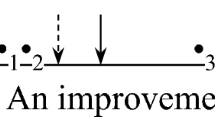Abstract
Approval voting is a system in which members can vote for as many candidates as they like in multicandidate elections. In 1987 and 1988, four scientific and engineering societies, collectively comprising some 350,000 members, used this election reform for the first time. Their reasons for adoption varied but centered around efforts to elect consensus candidates. Approval voting has indeed elected so-called Condorcet candidates, who can defeat all other candidates in pairwise contests. Moreover, these winners generally enjoy support among different classes of voters, so they are not merely “lowest common denominators,” as some analysts had feared. In at least one instance, approval voting would have led to a different winner from plurality voting (in which voters can vote for exactly one candidate); arguably, this winner would have been the better social choice because he had wider support than his closest opponent. On another occasion, approval voting led to “ideological voting”—in which the voting patterns reflected an underlying ordering of the candidates—but voting in most societies tends to be nonideological. Overall, the recent experimentation with approval voting has shown that it not only may make a difference but also elects broadly acceptable candidates.
Similar content being viewed by others
References
“Amendment to AMS By-Laws,” 1987,Amstat News 135 (May), 1.
Bellinger, Robert: 1991, “Sloan Wins Election,”Electronic Engineering Times (November 11), 82–83.
Brams Steven J.: 1982, “The AMS Nomination Procedure Is Vulnerable to ‘Truncation of Preferences,’”Notices of the American Mathematical Society 29(2), 136–138.
Brams Steven J.: 1988, “MAA Elections Produce Decisive Winners,”Focus: The Newsletter of the Mathematical Association of America 8(3), 1–2.
Brams Steven J.: 1990, “Constrained Approval Voting: A Voting System to Elect a Governing Board,”Interfaces 20(5), 67–80.
Brams Steven J. and Fishburn Peter C.: 1978, “Approval Voting,”American Political Science Review 72(3), 831–847.
Brams Steven J. and Fishburn Peter C.: 1983,Approval Voting, Birkhäuser Boston, Cambridge, MA.
Brams Steven J. and Fishburn Peter C.: 1988, “Does Approval Voting Elect the Lowest Common Denominator?”PS: Political Science & Politics 21(2), 277–284.
Brams, Steven J. and Fishburn, Peter C.: 1992, “Coalition Voting,”Mathematical and Computer Modelling (Formal Theory of Politics II), forthcoming.
Brams Steven J. and Nagel Jack H.: 1991, “Approval Voting in Practice,”Public Choice 71(1–2), 1–17.
“Briefing: Feerst in Close Call,” 1987,Science 235(4784), 26.
Condorcet, Marquis de: 1975,Essai sur l'application de l'analyse à la probabilité dés decisions rendues à la pluralité des voix, Paris.
Dummett Michael: 1984,Voting Procedures, Oxford University Press, Oxford, UK.
Federal Election Commission: 1989, “Report on the Visit by the Federal Election Commission to the Soviet Union, June 1989,” Federal Election Commission, Washington, DC, preprint.
Fishburn, Peter C. and Brams, Steven J.: 1991, “Yes-No Voting,” Department of Politics, New York University, preprint.
Fishburn Peter C. and Little John D. C.: 1988, “An Experiment in Approval Voting,”Management Science 34(5), 555–568.
Gardner, Martin (written by Lynn Arthur Steen): 1980, “Mathematical Ga,es (From Counting Votes to Making Votes Count: The Mathematics of Elections),”Scientific American 243(4), 16ff.
Gillman Leonard: 1987, “Approval Voting and the Coming MAA Elections,”Focus: The News-letter of the Mathematical Association of America 7(2), 2, 5.
Gordon Julie P.: 1981, “Report of the Secretary,”Econometrica 48(1), 229–233.
Jarvis John J.: 1984, “Council-Actions and Issues: Approval Voting,”OR/MS Today 11(4), 16.
Keller, Bill: 1987, “In Southern Russia, a Glimpse of Democracy,”New York Times (June 20), 1, 4.
Keller, Bill: 1988, “Moscow Says Changes in Voting Usher in Many New Local Leaders,”New York Times (September 21), A1, A7.
Kiely Tom: 1991, 1991, “A Choice, Not an Echo?”Technology Review 94(6), 19–20.
Lijphart Arend and Grofman Bernard (eds.): 1984,Choosing an Electoral System: Issues and Alternatives, Praeger, New York.
Little John and Fishburn Peter: 1986, “TIMS Tests Voting Method,”OR/MS Today 13(5), 14–15.
Mercik, Jacek W.: 1988, “On Some Consistency of Disapproval Voting” (in Polish), Institute of Production Engineering and Management, Wroclaw, Poland, preprint.
Merrill SamuelIII: 1988,Making Multicandidate Elections More Democratic, Princeton University Press, Princeton, NJ.
Nagel Jack: 1984, “A Debut for Approval Voting,”PS 17(1), 62–65.
National Academy of Sciences: 1981,Constitution and Bylaws (April 28).
Nurmi Hannu: 1987,Comparing Voting Systems, D. Reidel, Dordrecht, Holland.
Shabad, Theodore: 1987, “Soviet to Begin Multi-Candidate Election Experiment in June,”New York Times (April 15), A6.
Steen, Lynn Arthur: 1985, Private communication to Steven J. Brams (August 19).
White Stephen: 1989, “Reforming the Electoral System [USSR],”Journal of Communist Studies 4, 1–17.
Wright, Jeff: 1990, “School Funding Reform Options Unpopular,”Register-Guard (Eugene, OR) (May 16), 1C, 3C.
Author information
Authors and Affiliations
Rights and permissions
About this article
Cite this article
Brams, S.J., Fishburn, P.C. Approval voting in scientific and engineering societies. Group Decis Negot 1, 41–55 (1992). https://doi.org/10.1007/BF00562689
Issue Date:
DOI: https://doi.org/10.1007/BF00562689




